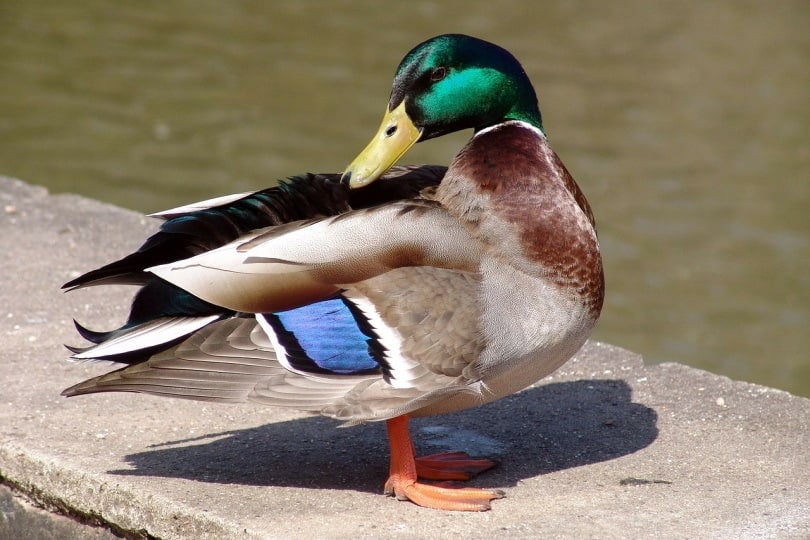Whether it’s a small farm pond, a marshy nature reserve, or a winding river, you’re bound to find a variety of duck breeds residing by the water. Washington State is no stranger to these water-loving birds and there are 27 breeds you can spot on your travels.
This list will introduce you to the dabbling ducks, diving ducks, and sea ducks you’ll spot in Washington State.
The 27 Duck Breeds in Washington State
1. American Wigeon
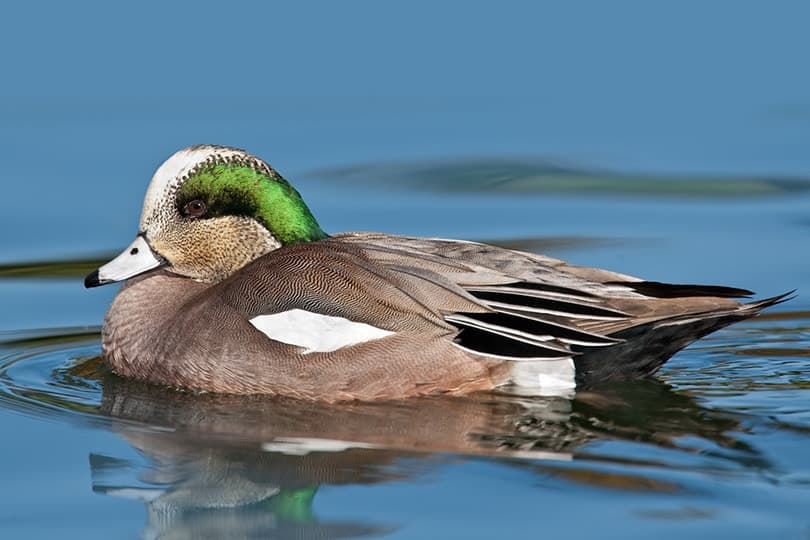
One of the more timid duck breeds, the American Wigeon is relatively small and prefers to stay away from humans. The marshes and wetlands they favor are quiet and the breed scares easily.
Male American Wigeons are recognized by the white crown and the green band behind their eyes along with a gray bill with a black tip. Females are generally a darker shade of brown than their male counterparts, although their heads are gray. Their bills tend to be blue but still have a black tip.
2. Eurasian Wigeon
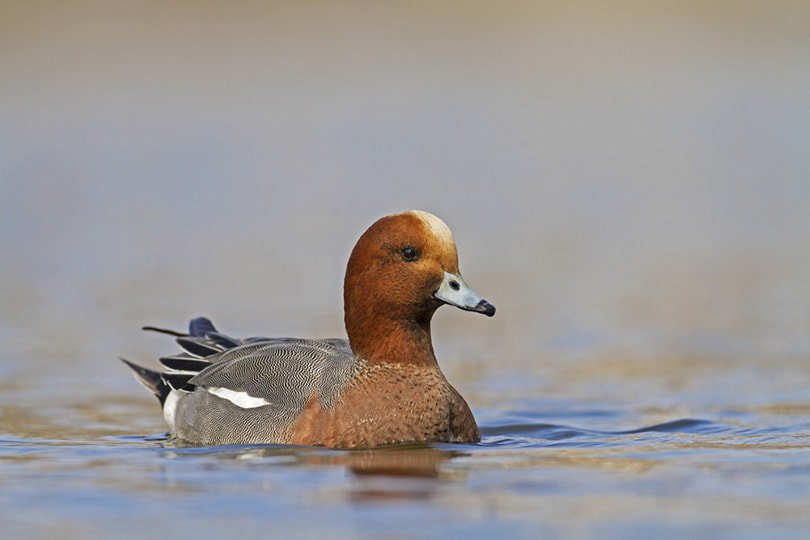
Preferring habitats like the American Wigeon, the Eurasian Wigeon are found on marshy ponds, lakes, or flooded fields.
Female Eurasian Wigeons are a chestnut brown color with dark feathers on their wings while the males are mostly gray with a light brown chest and darker heads. The males also have a light brown stripe on their foreheads and black throats.
3. Blue-winged Teal
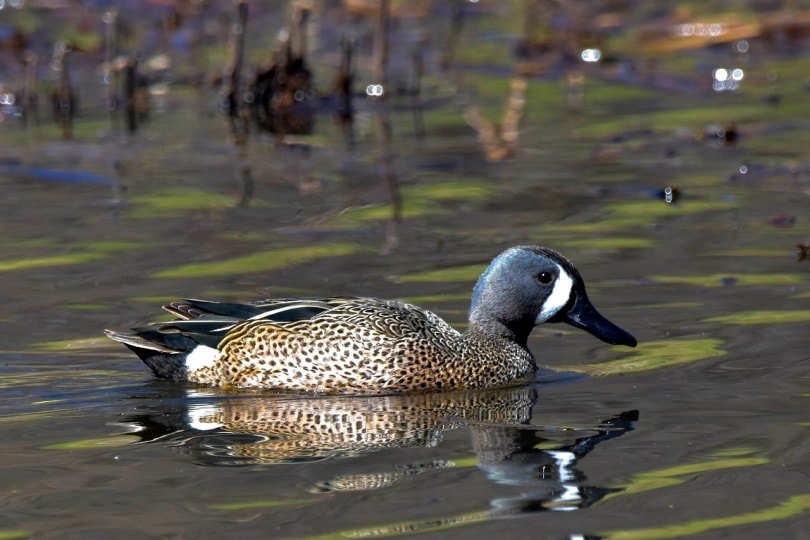
The Blue-winged Teal is one of the most common duck breeds in the USA and frequently the target of hunting. Both males and females are recognized by the blue and green feathers you can see on their wings during flight.
While both are primarily brown, the males have black spots, black wings, and black bills. Along with their blue-tinted heads, they also have a white band in front of their eyes. Females have a dark crown and eyeline.
4. Cinnamon Teal
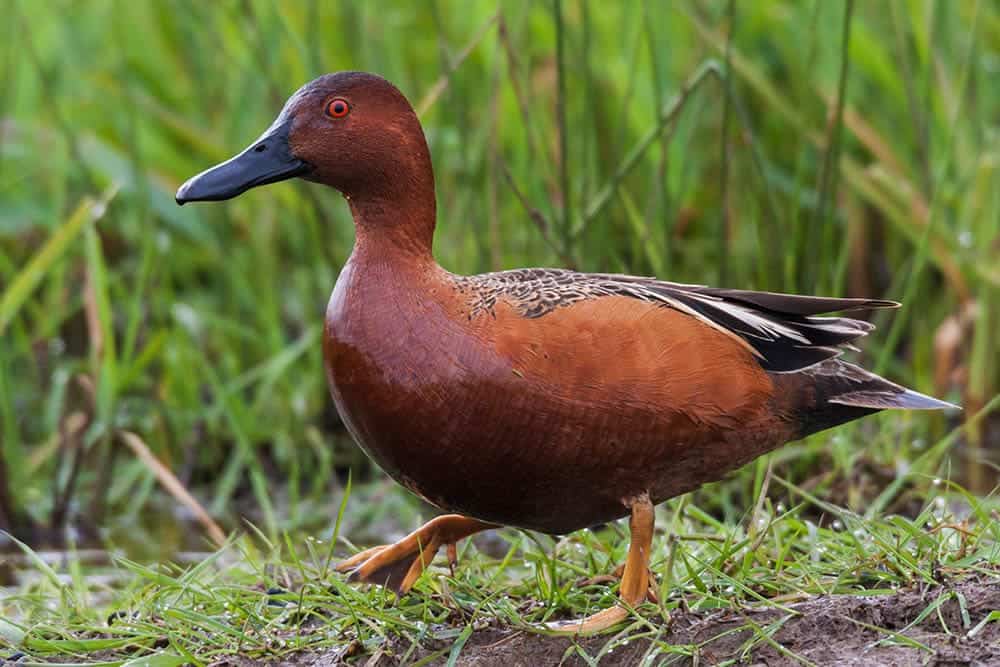
These ducks are sensitive to pollution and with their favored wetlands being damaged, the population of Cinnamon Teal ducks is slowly declining.
Male Cinnamon Teals have red eyes and are a light brown, cinnamon shade. They also have blue and green patches on their wings you can see while they’re in flight. The females are mottled brown with the same large black bill.
5. Gadwall
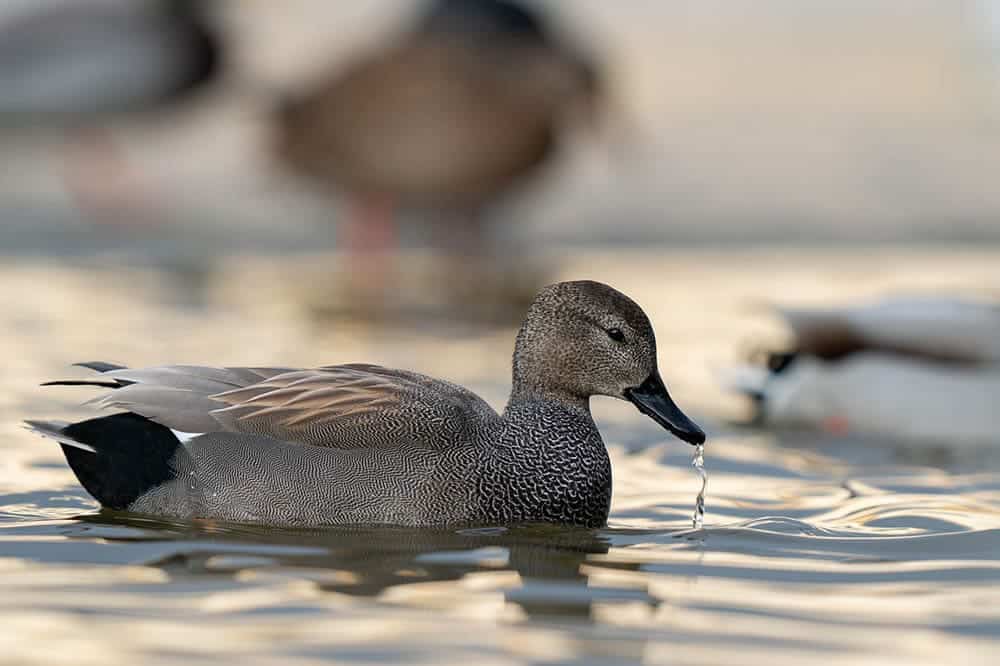
More subtle in color than other ducks, the Gadwall is frequently mistaken for other breeds. The females especially, with their mottled brown feathers, are often wrongly identified as Mallards due to their similar coloring. Female Gadwalls can be recognized by their orange and black bill along with the lack of the distinguishable blue secondary feather on the wings of Mallards.
Males, on the other hand, have a much simpler coloring. Their brown, black, and gray feathers look almost like scales with white trim. Black-billed, male Gadwalls have brown heads and brown feathers along their backs.
6. Green-winged Teal
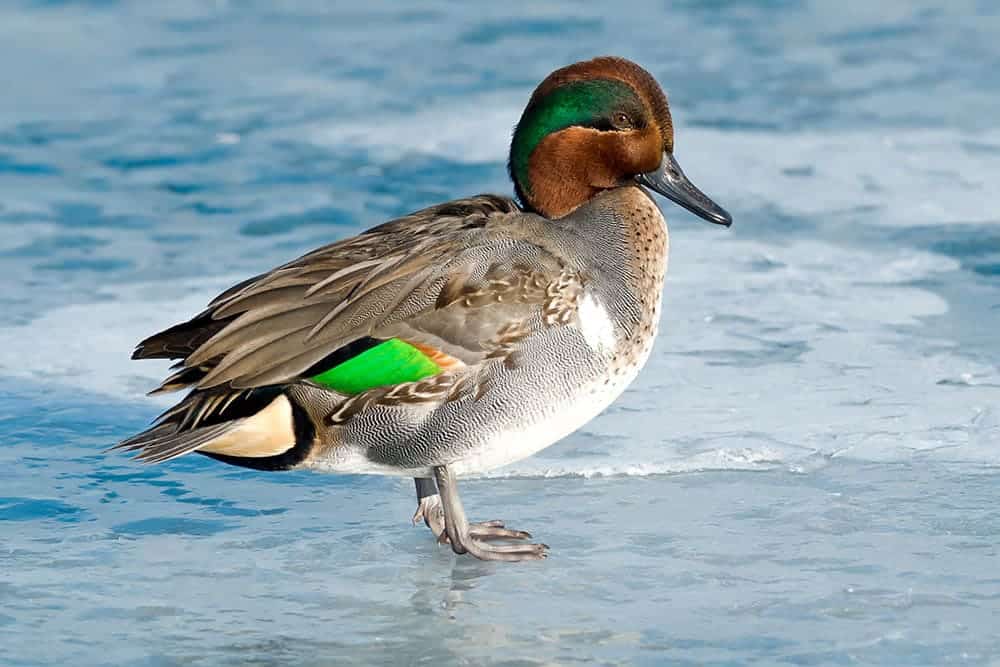
Despite being the smallest breed of dabbling duck in Washington State, the Green-winged Teal is also one of the most commonly hunted. You’re likely to find them spending time with other breeds too.
The females are like both Mallards and Blue-winged Teals. They have the same mottled brown feathers as the Mallard and the dark eye-line of the Blue-winged Teal, but they’re smaller than both breeds. Males are gray with a white stripe and their heads are chestnut-colored with a green patch. Both have green areas on their wings.
7. Mallard

As one of the most common duck breeds across the world, the Mallard is a familiar sight at ponds and lakes. Their widespread population and lack of wariness around people make them the most easily recognized breed.
Like most bird species, male Mallards are brighter in color than females. They have yellow bills, green heads, a thin white collar, a reddish-brown chest, a black rump, and a tail with a white tip. They have blue secondary feathers on their wings. Females also have the blue secondary feather on their wings, but overall, they’re a much more neutral color, being a mottled brown with orange or brown bills.
8. Northern Pintail
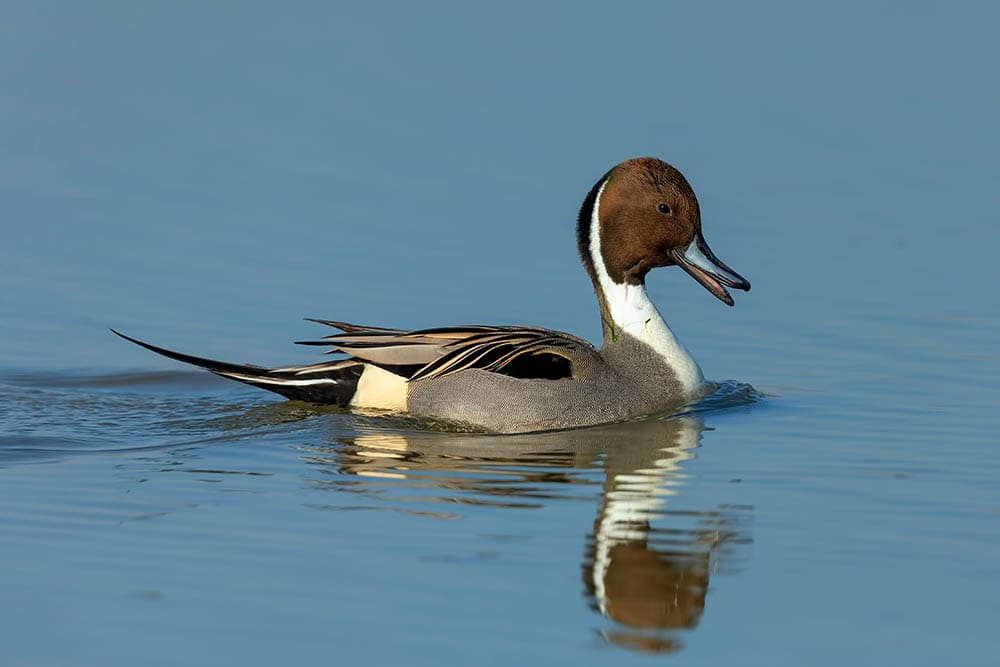
Recognized by their long necks and even longer pointed tails, the Northern Pintail isn’t fond of being around humans and generally keeps to the shallows of the quiet lakes they prefer. Both male and female Northern Pintails have pale black or gray bills and similar coloring. Males are gray with a brown head and white chest while the females are brown overall with a lighter, tan coloring for their heads.
9. Northern Shoveler
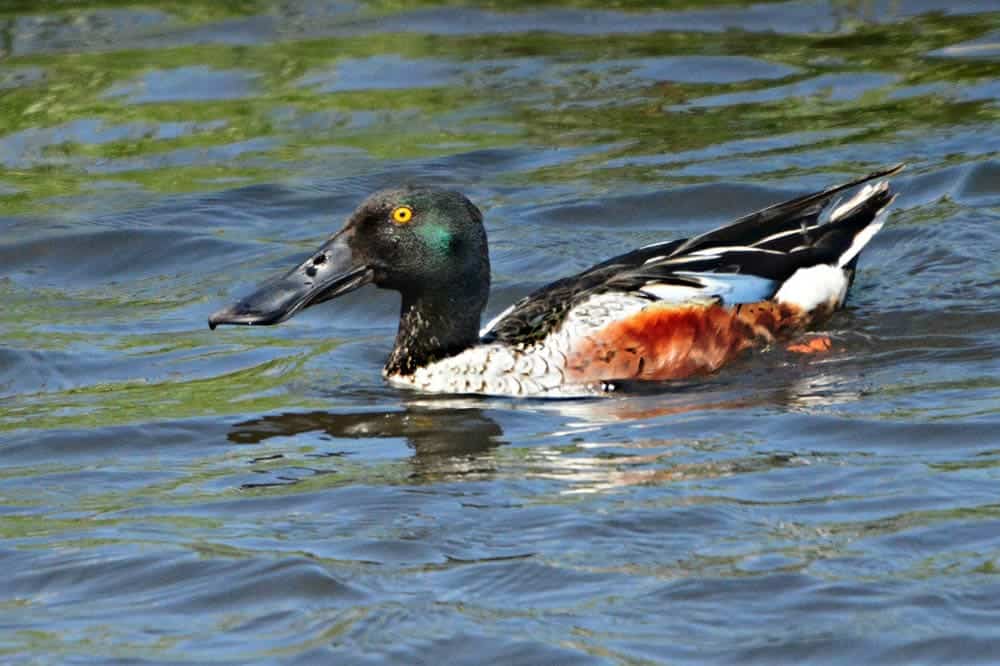
With a name like “Shoveler”, it’s no surprise these ducks have massive bills. It’s their biggest difference from the common Mallard. Male Northern Shovelers feature the same green heads as Mallards but that’s where most of the similarities lie. Unlike Mallards, the Northern Shoveler has a white chest, black back, yellow eyes, and brown flanks. The females are generally brown with blue patches on their shoulders.
10. Wood Duck
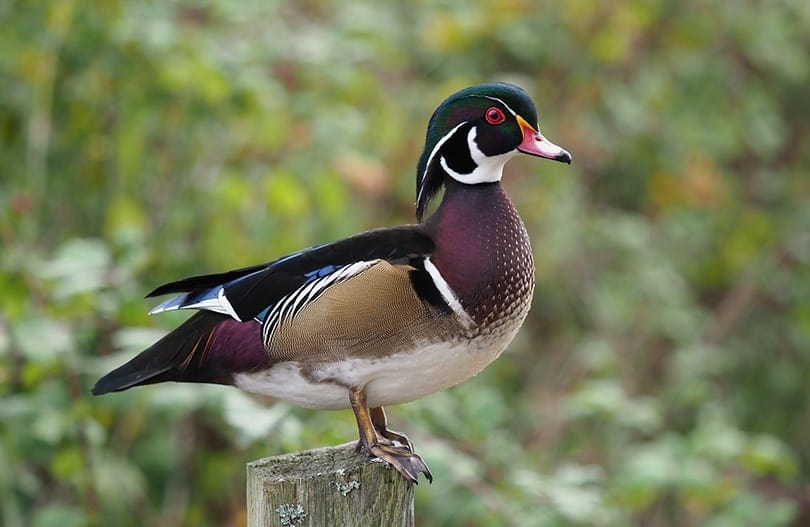
Unlike other duck breeds, the Wood Duck enjoys making their nests in trees or elevated nesting boxes. They’re also one of the most vibrantly colored duck breeds in Washington State.
Male Wood Ducks feature a variety of colors from their brown chest to their red eyes and the green crest on their heads. Their bills are orange and there are patches of black, white, and blue over their body. Females, like with other breeds, are a more neutral brown with gray heads. They have white eye patches and blue feathers on their wings.
The 6 Diving Ducks
11. Canvasback

One of the larger diving duck breeds, the Canvasback is rarely seen on land and will make its nests in floating vegetation. Both males and females are gray with black tails and chests. They have two major differences. The first is their eyes, red for males and black for females. Their heads are also different colors, reddish for the males and a more neutral brown for the females.
12. Greater Scaup

Not only does the Greater Scaup migrate long distances, but they’re also known for their diving prowess and can reach depths of 20 feet. Both males and females have black-tipped, blue bills but that’s their only similarity. Females are brown with darker heads and white patches at the base of their bills. The males are mostly gray with white flanks and a dark chest and rump; their heads are green.
13. Lesser Scaup

Although they don’t migrate as far as the Greater Scaup, the Lesser Scaup looks practically identical to the other breed. They can be easily mistaken for each other unless you pay careful attention to the size of their heads. Lesser Scaups have a less rounded head than the Greater Scaups.
14. Redhead
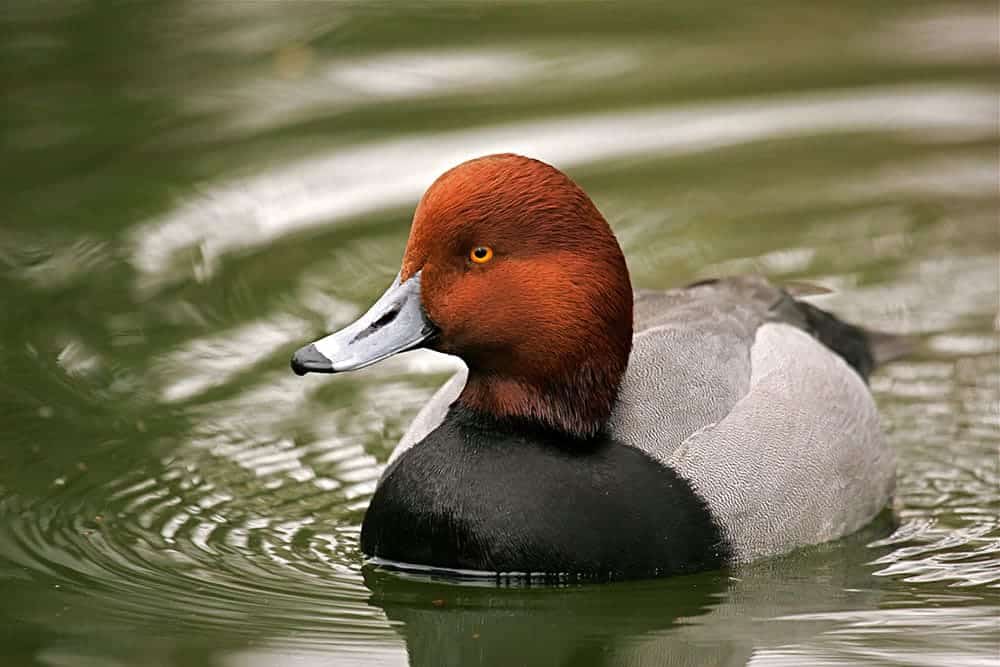
A sociable breed, you’ll often find Redhead ducks joining flocks of other breeds particularly when the weather is colder in the winter seasons. While female Redhead ducks are brown overall, these ducks get their names from the males’ red-colored heads. The males are generally gray with black chests and yellow eyes.
15. Ring-necked Duck

Unlike other diving ducks, the Ring-necked Duck favors shallow water. Despite their name, they don’t have a noticeable ring around their neck. Males are mostly black with gray flanks and yellow eyes while the females are brown with gray faces and white eye patches.
16. Ruddy Duck

As a breed that isn’t a strong flyer, the Ruddy Duck flees from predators by swimming away or diving instead of taking flight like other duck breeds. Their unique coloring makes them easy to recognize. Sporting blue bills and white cheeks, male Ruddy Ducks are brown with stiff black tails, black caps, and a dark patch on the back of their necks. Females have black bills and are a lighter shade of brown.
The 11 Sea Ducks
17. Barrow’s Goldeneye
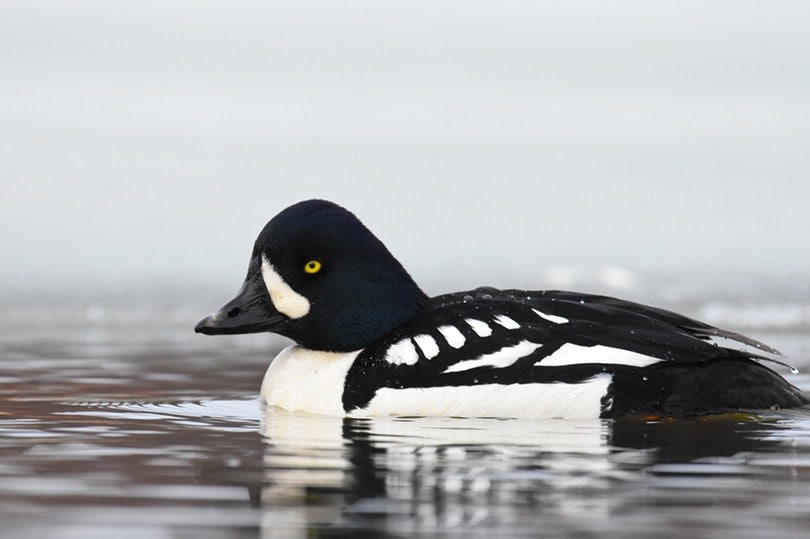
The Barrow’s Goldeneye is found on rocky coastlines in winter when the forest lakes freeze over. Gaining their name from their distinct yellow eyes, the males of the breed are primarily black and white with white markings on the wings and face. The females are gray with brown heads and yellow bills.
18. Black Scoter

Favoring the coastline during the winter months, the Black Scoter isn’t often seen in Washington State during other times of the year. The males are easy to recognize by their black feathers and the orange knob at the base of their dark bill. Female Black Scoters are mostly brown with a gray head and a dark cap.
19. Bufflehead

Although Bufflehead ducks are small, their appearance makes them easy to identify even for beginners. Males are mostly black with white patches on their heads, chest, and flanks. They also have green areas on their cheeks. Females, on the other hand, have white cheek patches, dark heads, and a brown body.
20. Common Goldeneye
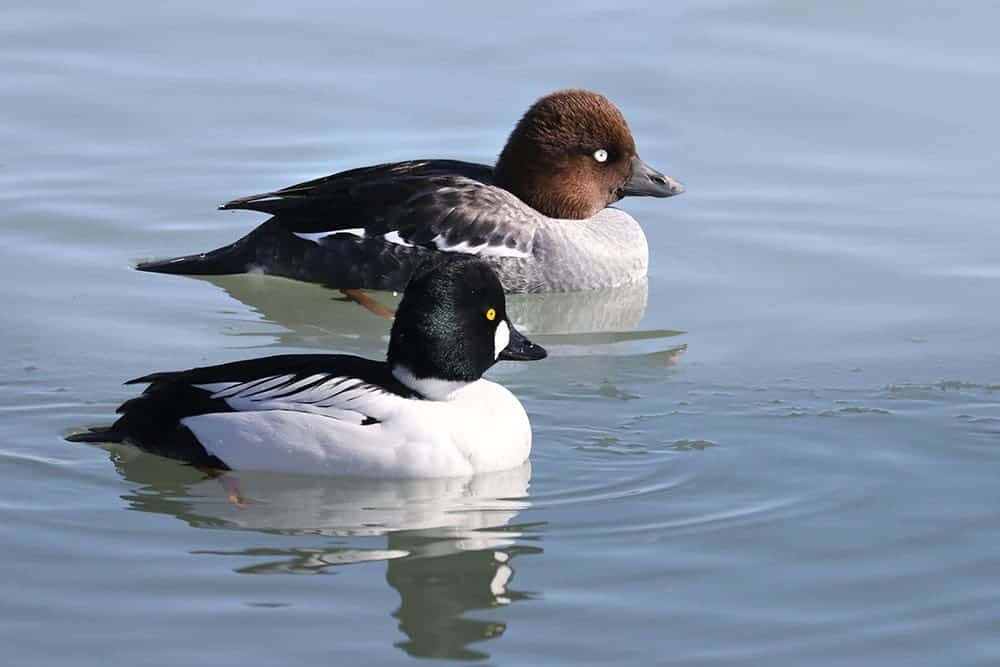
Able to stay underwater for about a minute, the Common Goldeneye is a breed that excels at diving. The males are white with black feathers along their back and rump; their heads are green with white cheeks. Female Common Goldeneyes are gray with white collars, brown heads, and yellow-tipped, dark bills. They get their name for their distinct yellow eyes.
21. Common Merganser

You’ll often find other birds stealing fish from the Common Merganser as the breed is well known to be excellent fishers. They’re larger than the other Merganser breeds but have the same thin bills. Male Common Mergansers have a green head, white body, and black back. The females have brown heads and gray bodies.
22. Harlequin Duck

Unlike other breeds that prefer calmer environments, the Harlequin Duck favors fast-flowing rivers and rocky, windy shorelines. What they lose in size, they make up for in appearance, and they’re well known for their vibrant plumage.
While the females are brown with pale undersides and white spots behind the bill and eyes, the males are mostly a dark blue color. They have brown patches on their flanks with white spots along their body and face.
23. Hooded Merganser
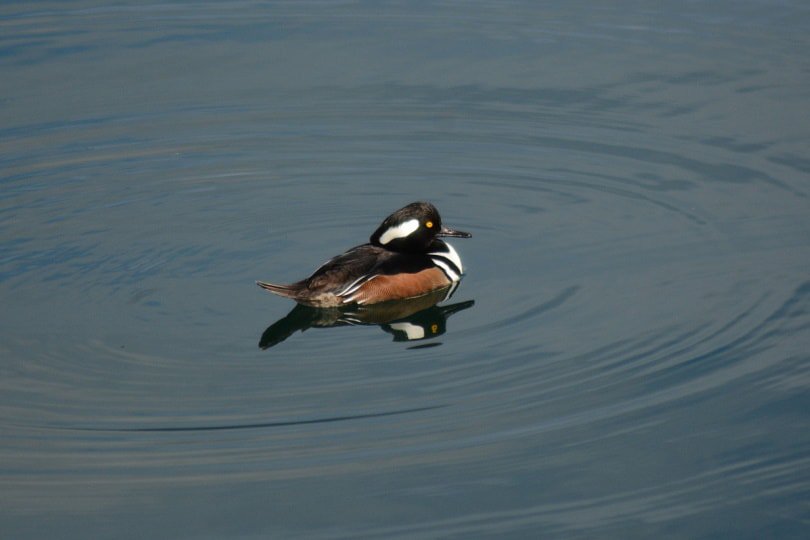
Found in shallow ponds and rivers, the Hooded Merganser will often trick other females to raise their young for them. They are a relatively small breed, and the males are recognized by their black and white crest and yellow eyes. Female Hooded Mergansers have a Mohawk-style crest that’s lighter in color than the males, and they’re brown all over.
24. Long-tailed Duck
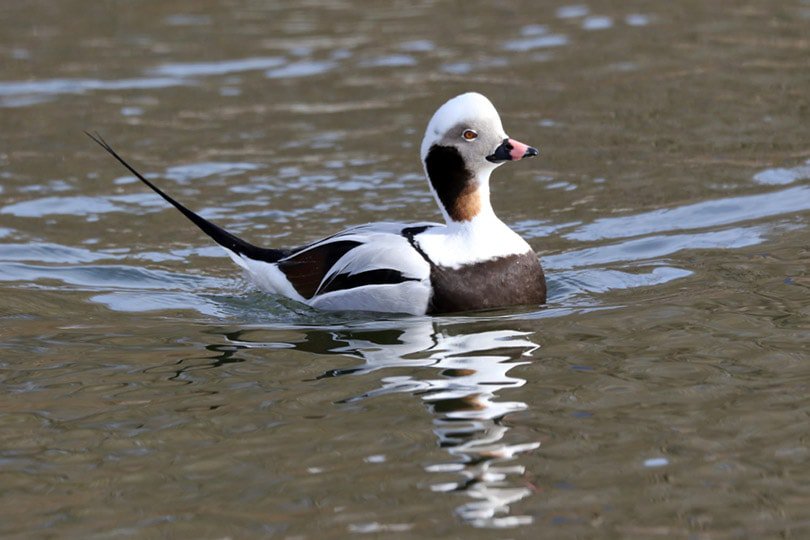
Timid around people, the Long-tailed Duck is found on the coastline during winter. You’ll often find them in large flocks in areas away from land. They can dive at least 200 feet.
Alongside the male Long-tailed Duck’s distinctive long tail, their plumage depends on the time of year. Summer finds them black with white patches on their face while winter sees white bodies with brown, black, and gray faces. The females, in comparison, stay the same brown and white color year-round.
25. Red-breasted Merganser
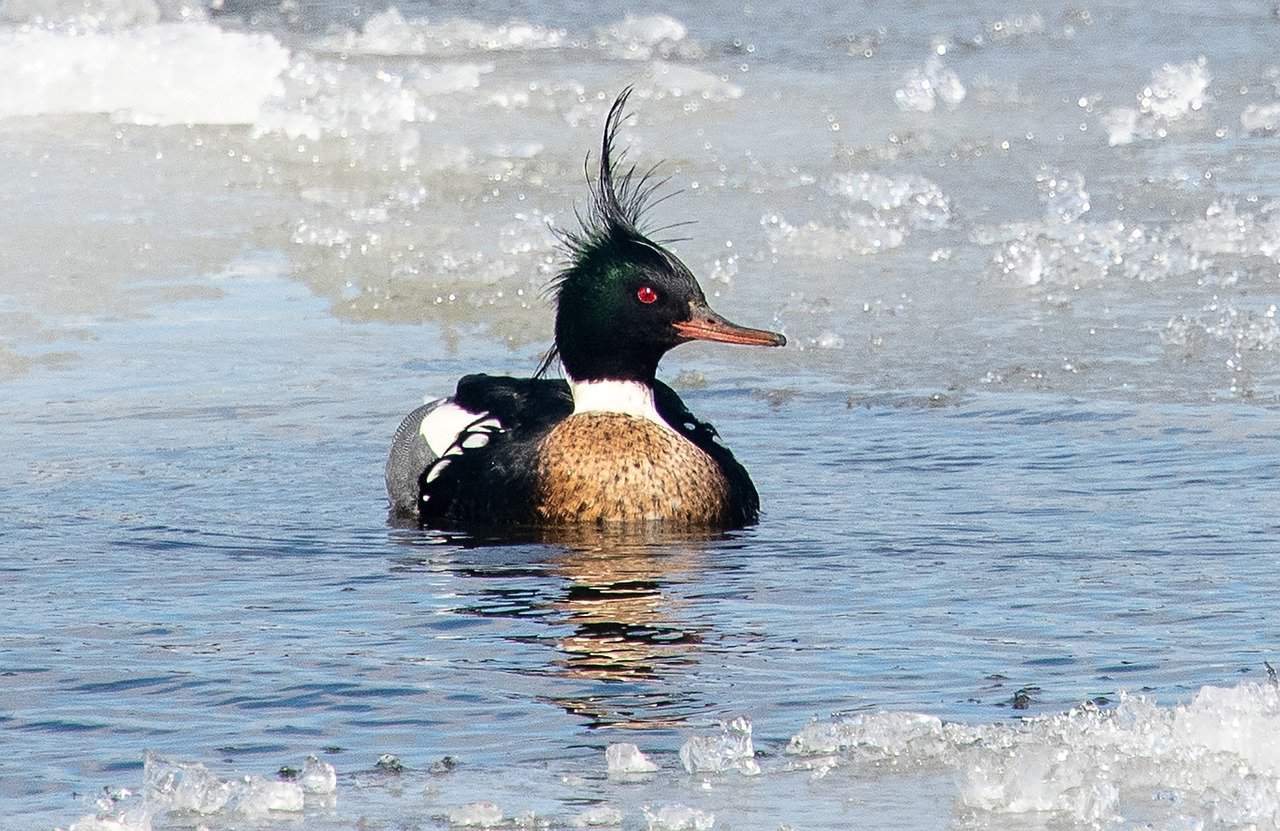
Similar to the Hooded Merganser, the Red-breasted Merganser also has the same thin bill. They’re also not one of the most commonly hunted breeds due to their fish-based diet. While the females are a simple gray, breeding males have a reddish-brown chest, green heads, and a spiky crest.
26. Surf Scoter

The Surf Scoter enjoys joining large flocks of both White-winged Scoters and Black Scoters. They’ve earned the nickname “Old Skunkhead” due to the distinctive white patterning on the male’s head. Like the Black Scoter, the males are mostly black but the knob at the base of their orange bill is patterned with black and white. The female’s plumage is a simple brown.
27. White-winged Scoter

Larger and less common than the two other Scoter breeds found in Washington State, the White-winged Scoter can be found among flocks of Surf Scoters and Black Scoters. You can recognize the males with the white patterning on their wings, orange-tipped bill, and the white eyepatch. The females are mostly brown with white patches on their wings, cheeks, and the base of their bills.
- Related Read: 32 Fascinating & Fun Duck Facts You Never Knew
 Final Thoughts
Final Thoughts
While the duck breeds mentioned on this list vary in how common they are, there’s plenty to find in Washington State depending on the time of year. Some breeds prefer the coastline during winter while others are year-round residents of your neighborhood pond. Either way, we hope this list helped you learn more about your favorite duck breed.
Featured Image Credit: AnnaER, Pixabay
